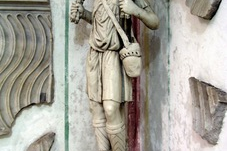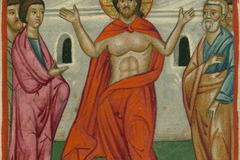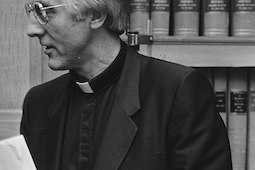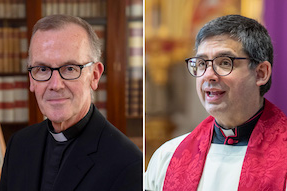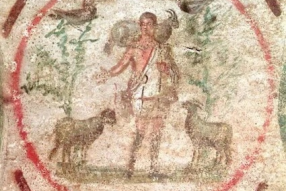Sunday Reflection with Fr Robin Gibbons - 16 December 2017

Matthias Grünewald - Isenheim Altarpiece
Advent 3 2017. Do you like church music? By that I mean do you enjoy singing and listening to the vast and wonderful repertoire of sacred music that the Christian church has? I certainly do and it seems to be in my ancestral DNA, on my paternal side there have been an number of talented church musicians, my Grandfather and Uncle Geoffrey (who turns 90 this Sunday) clocked up this year 100 years of Organ playing between them, Geoffrey still does it! I have always sung from being a small boy. I was trained in our monastic choir to sing good plainchant and now as a priest and sometimes cantor enjoy the mixture of old and new.
In the distant past our family had several ancestors who were talented church musicians, one the well known Tudor Church musician, Orlando Gibbons, whose music includes the haunting anthem, 'This is the record of John" which is still sung throughout Cathedral and Parish Church Choirs today. The words are of course from the opening chapter of St John's Gospel , where the tale of John's ministry includes a specific dialogue, which Gibbons uses in his anthem. (Jn 1:19-23) These words take on a different dimension when put to music; Augustine said singing is praying twice, so also hearing music is a deeper and emotional aspect of prayer that fills our hearts and minds.
In the chapter we are first of all reminded that John is a testimony to the Light that is coming into the world in order that we might believe in that Light. Then comes this singular dialogue between Baptist and his interlocutors, the priests and Levites. John is asked who he is and to each question his answer is either 'I am not' or 'no! John's response is important, for it sets before us the witness of somebody whose life is totally bound up in a mission to proclaim and witness to truth, not to place themselves in the front of the media and popular eye. This section is called John's testimony, his witness statement if you like, and it leads us to two key sentences:
He said:
"I am the voice of one crying out in the desert,
'make straight the way of the Lord,'
"as Isaiah the prophet said." (Jn 1:23).
This is a reminder of our own Christian path, before Christ is recognised we have to prepare the way, yes even now in our own time, because we too are often voices in a different wilderness, but this then leads to a second statement:
'John answered them, "I baptize with water; but there is one among you whom you do not recognize, the one who is coming after me, whose sandal strap I am not worthy to untie". ' (Jn 1:26-27) Here we are challenged; is our testimony like John's, a record of our lives a witness to the Saviour? The gift of the Baptist is to push us onwards, reminding us that we like him have seen the Lamb of God, the Messiah, in so many ways. Sacramentally in liturgy, particularly the Eucharist, in our relationships, in the stranger, and in the living Word where these words take root in our hearts, so that we may proclaim in our lives that the Light has come. May John's record be ours too! Maranatha!
Lectio Divina
Reflection on Grunewalds Isenheim Altarpiece by Karl Barth
"….Its subject is the incarnation. There are three things to be seen in the picture, and it is difficult to say where the observer should begin. In the background upon the heights of heaven, beyond earth's highest mountains, surrounded by innumerable angels, there is God the Father in His glory. In the foreground to the left there is the sanctuary of the old covenant. It also is filled with and surrounded by angels, but inexorably separated from the background by an immensely high, gloomy partition. But towards the right a curtain is drawn back, affording a view. And at this point, at the head of the whole world of Advent looking to see the Messiah, stands Mary as the recipient of grace, the representative of all the rest, in adoration before what she sees happening on the right side. Over there, but quite lonely, the child Jesus lies in His mother's arms, surrounded with unmistakable signs reminding us that He is a child of earth like all the rest. Only the little child, not the mother, sees what is to be seen there, the Father. He alone, the Father, sees right into the eyes of this child. On the same side as the first Mary appears the Church, facing at a distance. It has open access on this side, it adores, it magnifies and praises, therefore it sees what is indeed the glory of the only-begotten of His Father, full of grace and truth. But it sees only indirectly. What it sees directly is only the little child in His humanity; it sees the Father only in the light that falls upon the Son, and the Son only in this light from the Father.
This is the way, in fact, that the Church believes in and recognises God in Christ. It cannot run over to the right side, where the glory of God can be seen directly. It can only look out of the darkness in the direction in which a human being is to be seen in a light, the source of which it cannot see itself. Because of this light streaming down from above, it worships before this human being as before God Himself, although to all visual appearance He is literally nothing but a human being. John the Baptist too, in Grünewald's Crucifixion, can only point-and here everything is bolder and more abrupt, because here all indication of the revelation of the Godhead is lacking-point to a wretched, crucified, dead man. This is the place of Christology. It faces the mystery. It does not stand within the mystery. It can and must adore with Mary and point with the Baptist. It cannot and must not do more than this. But it can and must do this "
(Barth, K., 2004. Church dogmatics: The doctrine of the Word of God, Part 2, London; New York: T&T Clark. p.125).



